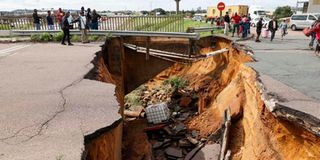South Africa floods kill over 250 in Kwa-Zulu Natal

A resident of Umlazi township looks at containers that fell over at a storage facility following heavy rains and winds in Durban, South Africa on April 12, 2022. Days of super-intense downpours in KwaZulu-Natal have left over 250 people dead.
Days of super-intense downpours in South Africa's Indian Ocean Province of KwaZulu-Natal have left over 250 people dead, many missing and thousands displaced – with more heavy rain on the way and likely to last into next week.
A series of cyclones and tropical storms, which have hit the south-eastern parts of Africa, as well as Madagascar, have culminated over the last several days in record-breaking downpours across South Africa's most populace province, sweeping away bridges, roads, buildings and vehicles, isolating communities and leaving a trail of destruction.

Residents stand next to an embankment that collapsed following heavy rains in New Germany, near Durban on April 12, 2022.
KwaZulu-Natal regional minister for health Nomagugu Simelane-Zulu has confirmed that the widespread flooding had claimed at least 253 lives by Tuesday evening, with more bodies being recovered since.
The KwaZulu-Natal regional authorities have already determined that national government should declare a regional state of disaster, and the Treasury has told President Cyril Ramaphosa that there were funds being put aside to help respond to the mass destruction in a province well used to tropical storms – but entirely unready for the extreme weather of the last week.

A rescue helicopter lands on a street leading to Umlazi township following heavy rains and winds in Durban, South Africa on April 12, 2022.
Incessant and extremely heavy rainfall has been reported across the region, with numerous places reporting more rainfall in a single day than usually recorded for a month in the rainy season, which ought to be ending but which is showing only signs of intensifying over the next several days.
With rain briefly holding off early Wednesday, President Ramaphosa travelled to KwaZulu-Natal to visit affected communities and to establish an on-the-ground assessment for himself of the extent of the damage.

A general view of the flooded roads leading to the paper and packaging manufacturer Mondi following heavy rains and winds in Durban, South Africa on April 12, 2022.
Speaking to overwrought parents of four children washed away along with the building they were in, and presumed dead, the obviously deeply moved President was almost left speechless by the tragic loss about which he could do little, except to express his sorrow and consolation.
He promised the grieving parents, who are very poor and cannot afford to bury four children at once, that authorities would assist them with burial costs, once their children's remains were recovered.
With major roads closed due to washouts and many landslides, plus numerous bridges rendered unusable or washed away, travel across the province has been severely hampered, much slowing disaster management responses.
With a brief lifting of the rain, aerial surveys of the affected areas showed vast swathes of damage, affecting mostly poor high-density informal settlements, but also up-market expensive suburbs of Durban and other centres.

Residents of Umlazi township stand over a bridge and watch containers that fell over at a storage facility following heavy rains and winds in Durban, South Africa on April 12, 2022.
Many open fields, school yards, even Kingsmead sports ground in Durban where a cricket test match between South Africa and Bangladesh was played, were swamped with large areas of standing water, the ground completely saturated by the seemingly ceaseless recent rains.
Climatologists have linked the spate of heavy-rainfall weather, including three cyclones and two tropical storms in the late southern hemisphere summer season, to global warming, and the La Niña sea temperature phenomenon in which warm waters move across the Pacific Ocean, causing knock-on effects around the world.
Even as President Ramaphosa, accompanied by national and regional ministers, continued his visits to affected families and communities, the predicted return of the rains began, setting the scene for a greater-yet disaster to unfold.
The South African Weather Service said more rain with heavy downpours was expected in the flooded areas and associated border province regions, lasting into early next week.

A general view of a crack in the road following heavy rains and winds in Durban, South Africa on April 12, 2022.
The El Niño-Southern Oscillation (ENSO) is currently in a La Niña state, with forecasts that it will likely remain so for weeks to come, at least.
Correlating with the Pacific Oceanic phenomenon, south-eastern and central regions of Southern Africa have this year been inundated by repeated and extended rainfall events.
Mozambique has also been heavily hit, with lives lost and much damage caused there, as well as Zimbabwe and Malawi, both suffering some flooding, and even usually arid Botswana has been impacted.
Climate experts said it was clear that regional weather patterns, not merely in this part of Africa but globally, were already in a "new weather pattern regime", and that it was therefore "almost impossible" to say what might next happen, except that it was likely to be "historically extreme and unprecedented".





